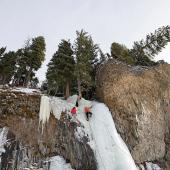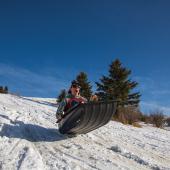GPS Geocaching
Until relatively recently, �GPS� was an acronym familiar only to gearheads and a few fatcats who were able to access the U.S. Government�s Global Positioning Satellite system to steer their BMWs to the nearest Taco Bell. But the ever-shrinking costs of the technology, combined with the further de-scrambling of GPS signals in 2000, have given an increasing number of civilians unprecedented accuracy. For as little as a hundred bucks, the average Joe can pick up a basic receiver and access signals from the government�s 24 GPS satellites, pinpointing his position with an accuracy of up to five or ten feet.
Rain or shine, a GPS receiver with a clear view of the sky uses radio signals to determine the exact distance from a minimum of four orbiting satellites. In just a few seconds, the receiver applies a trigonometric formula and determines the exact latitude, longitude, and elevation at the user�s location. The military still monopolizes the most accurate signals, but Joe Six-Pack just needs to find his way back to the car, not drop a daisy-cutter on a machine gun nest.
The GPS unit can also direct the user to �waypoints� that have been fixed into the receiver�s memory. These can be points that the user has already been to, giving the GPS owner the remarkable ability to never get lost (although dead batteries and unread instruction manuals should ensure that the heart-wrenching �lost in the woods� literary sub-genre never goes completely out of style). Or, instead of retracing their steps, GPS users can also seek out latitude and longitude coordinates that someone else has told them about, perhaps a spectacular hidden spot, or a place where something has been left for them to find. Hence �geocaching.�
Geocaching involves leaving �caches� in wild, or not-so-wild, places and posting the coordinates online, so that other GPS users can find them. The caches consist of ammo boxes or Tupperware containers full of small-time rewards like toy cars and postcards which you are supposed to trade out with some of your own junk. The official website, ww.geocaching.com, lists the waypoints for nearly 50,000 caches in 166 countries, including all 50 states. There are around 150 caches hidden in Montana alone, and at least a couple dozen in or near Bozeman.
The degree of difficulty in finding caches can vary widely. A cache hidden in a shrub next to a parking lot simply involves a bit of driving around, while a cache at the bottom of a cliff in the remotest wilderness will have fewer visitors. Caches can also incorporate numerous variations, such as the tracking of �travel bugs� that geocachers take from one cache and move to the next, and �multicaches� where waypoint coordinates are hidden in successive caches.
I started my career as a cache hunter by tracking down one of the most popular caches in Bozeman, which is also naturally one of the easiest to find. Labeled �Urban Bridges� on geocaching.com, the cache is hidden off a set of trails on the edge of town. A number of people who had logged their find of the cache on the website had complained about being on the wrong side of a river while following their GPS units to the cache. As amazing as the technology is, the GPS normally won�t tell you the best route unless you shell out for sophisticated mapping software. The basic unit just gives you a big arrow that more or less says, �Go that way,� without any consideration for whatever difficult terrain may lie between you and your goal.
The fools, I thought. The cache is named after a bridge, which I thought was a pretty good indication of the easiest route. After crossing the only bridge in sight, my receiver began to tick off the decreasing distance to the cache: 500 feet, then 400 feet, and so on until at around 70 feet the arrow pointed directly off the trail. I wandered into the thick brush and began scanning for the cache. As the GPS got to around 10 or 15 feet, the arrow suddenly flipped around. This was about the limit of the GPS�s accuracy. A space of around 15-20 feet in diameter doesn�t sound like a lot, but in the midst of all that underbrush it was a lot of ground to cover.
It took a few minutes of scrounging under a variety of woodland debris, but I finally found the cache, a small Tupperware container filled up with kite string, refrigerator magnets, and plastic farm animals. I left a squeaky toy and decided not to take anything. After writing a blurb in the cache�s logbook, I fled the scene before the mosquitoes could finish me off.
After this initial success, I was hooked, and even hid my own cache recently. Likewise, geocaching is mushrooming in and around Bozeman. New Bozeman caches appear on geocaching.com on a regular basis, and the list of geocachers in the area keeps getting longer. For tips on getting started in geocaching, be sure to check out the website.











